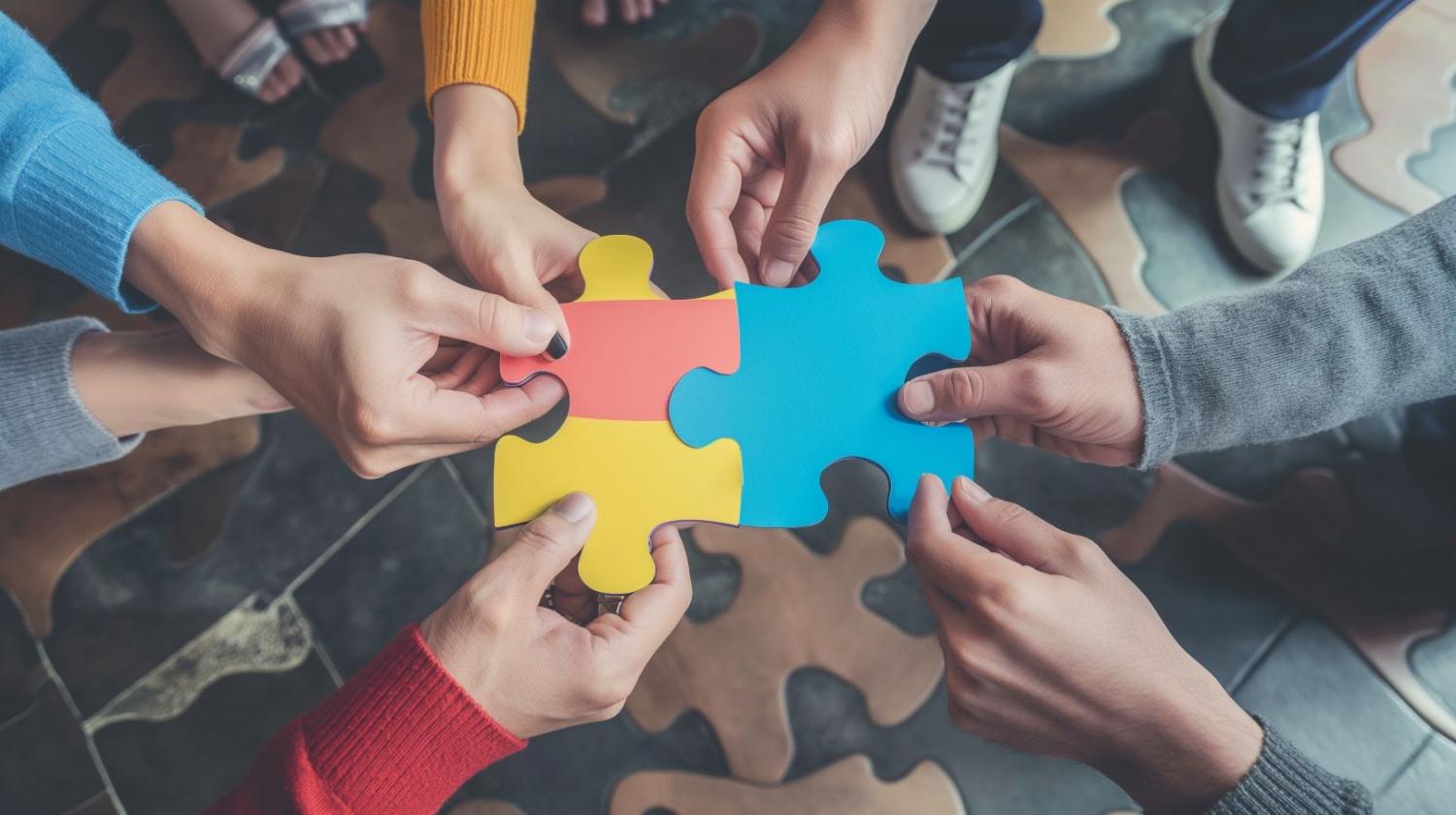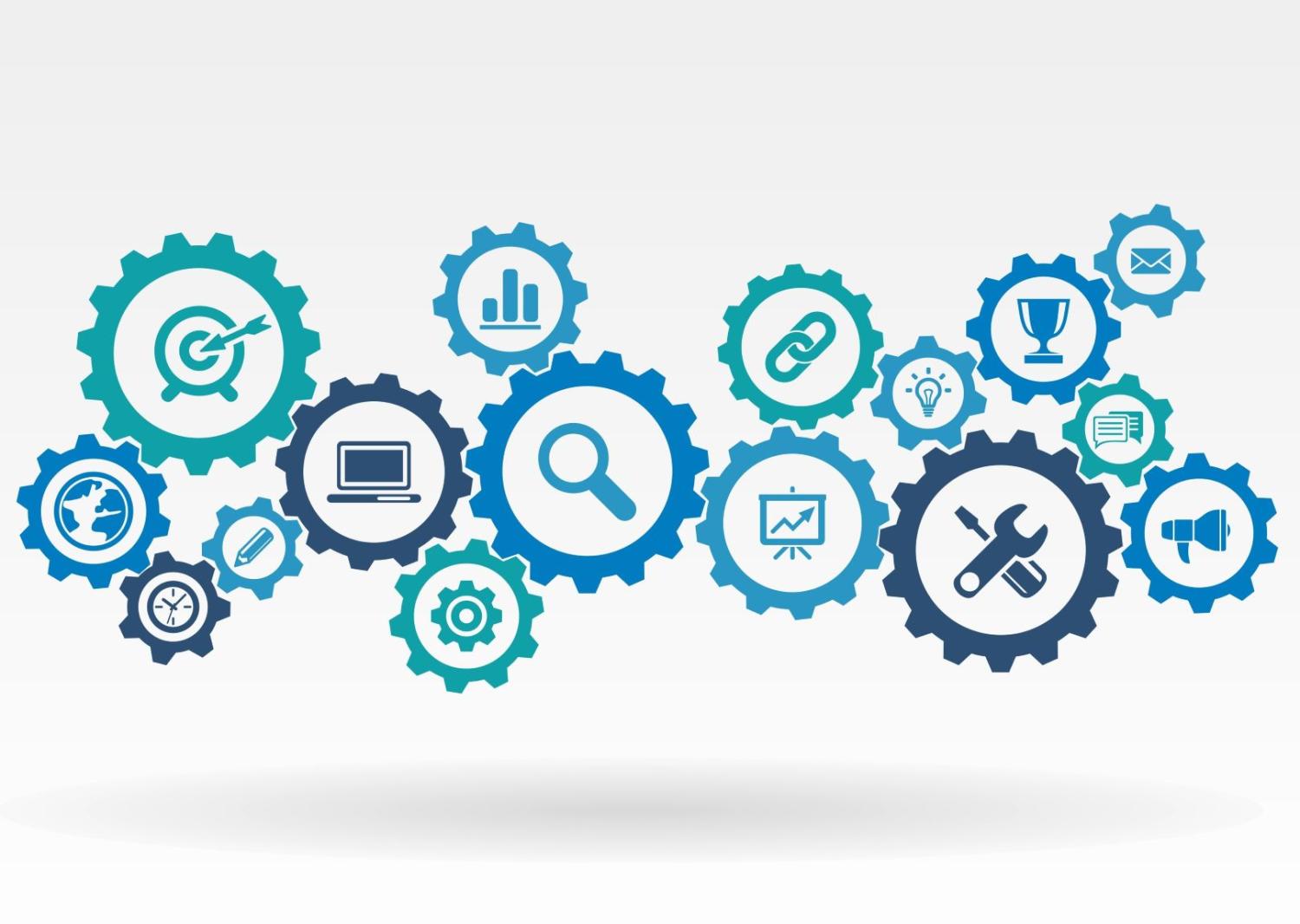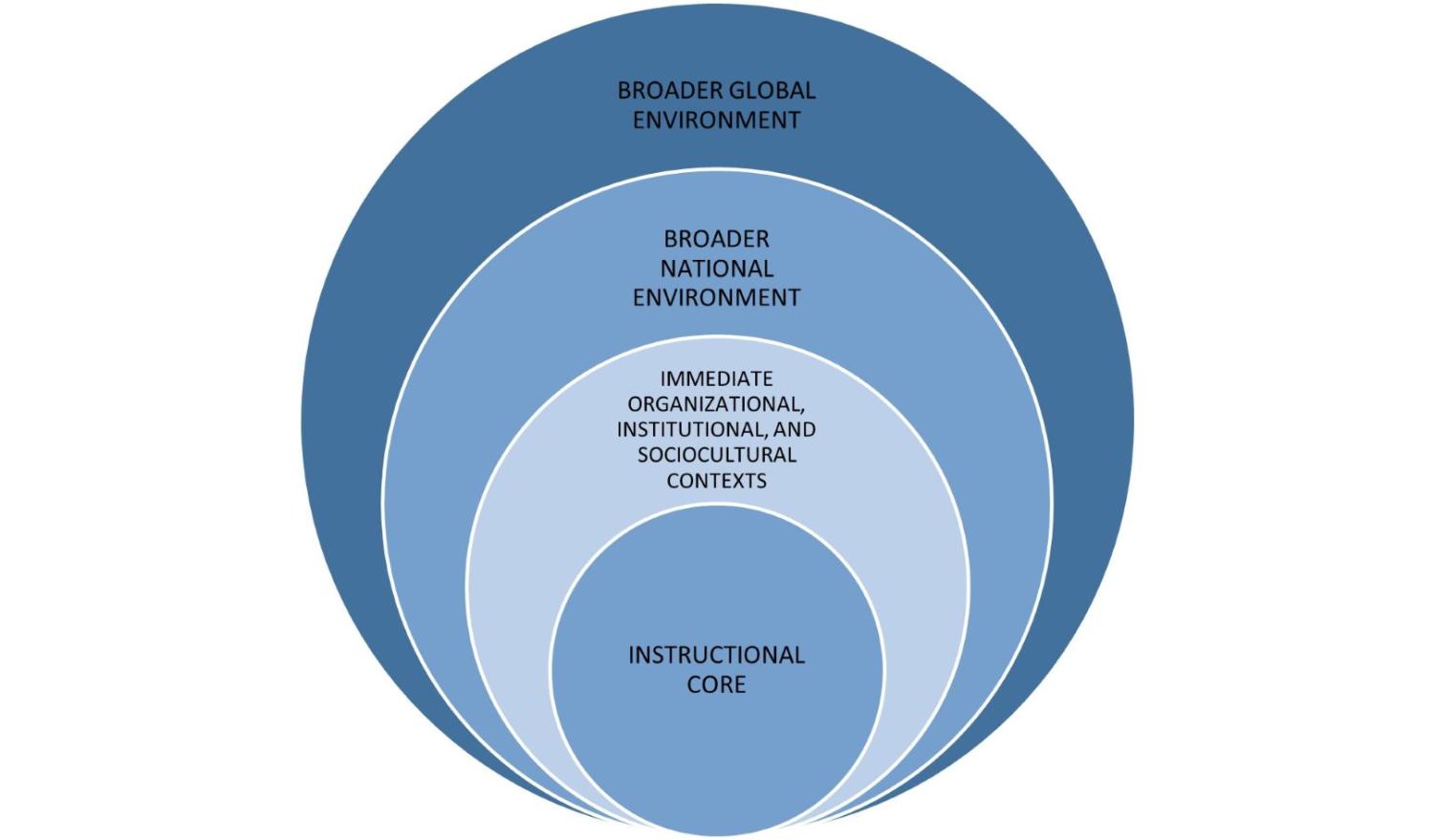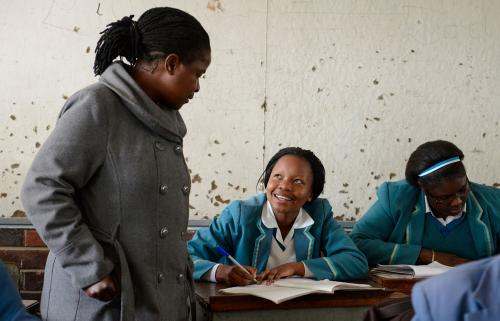As education continues to debate a myriad of issues, from student wellbeing to foundational learning outcomes to teacher recruitment, it’s worth taking a step back and reflecting on how deep change happens. That’s a big topic, we know.
Over the decades, there have been various broad theories of change put forward that are meant to inform how large numbers of personnel, money, time, and effort should be marshalled to improve education. Do education systems evolve naturally—and should that process simply be helped along? Is change brought about by introducing new technologies or practices into an education system? Or is change best effected by ambitiously restructuring the whole of education simultaneously? Should we be disrupting existing education systems, deconstructing them, strengthening them, or adjusting them?
This essay considers two currently favored approaches toward education change and asks if they might perform better if they joined up.
Scaling for impact is an approach focused on introducing a new innovation, initiative, or idea and expanding and deepening its effects on people and institutions. Systems transformation is an approach focused on understanding the whole ecosystem (see figure 2 later in this essay) and changing key parts of the system to alter the interactions across the whole ecosystem, thereby transforming how it works.
As two approaches to sustainable education improvement, scaling impact and systems transformation have both been around for a few generations now; they’re old enough to make their own decisions in life. And both are currently popular: the king and queen of the dance, to build the metaphor.
We in the Millions Learning team at the Center for Universal Education at the Brookings Institution suspect their popularity is, in part, because both acknowledge how difficult it is to effect real education change in a location. Both understand that it requires pulling on the most promising aspects of large numbers of people, polices, and places to create conditions for lasting change. Both approaches are improvements over prior generations of narrowly defined single-point or project-minded reform views in education. And so, increasingly, there’s talk of whether—and, if so, how—the two paradigms might fit together.
This essay explores such a union: first we propose the idea, then we put forward four principles for integrating the two approaches, and finally we articulate six ingredients necessary for the union to succeed.
What is scaling impact?
- Spreading a promising innovation, policy, or practice in order for it to become the new normal in a location.
- Scaling encompasses a range of approaches—from deliberate replication to organic diffusion to integration within national systems—meant to expand and deepen impact leading to lasting improvements in people’s lives.
- Our definition prioritizes scaling impact (a focus on scaling the effects of the innovation, not simply growing or replicating the innovation itself).
What is systems transformation?
- Restructuring education in a location so it operates differently and better.
- Systems transformation abides by the facts that: (1) education is an ecosystem of many parts (including both ‘soft’ systems and ‘hard’ systems) interacting with each other in interdependent, organic ways. And (2) a system’s energy is located in the inter-relationships among parts (not in the parts themselves). Therefore, (3) improving the system requires differently aligning, structuring, attaching, or otherwise engaging how the parts operate with each other.
Part 1—Is it time for scaling and systems change to marry?
Would integrating the two be a match made in heaven or a marriage of convenience? Are they in the just-friends stage, meeting up but not ready for a life together? Are they better off on their own?
In 2022, Richard Kohl offered four ways to integrate the paradigms of scaling and systems change. He put forth a kind of continuum from loose association (be mindful of systems while scaling) all the way to defining scaling as engaging multiple parts of the system for synergy. In favor of scaling matching up with systems change, he suggested that not doing so limits scaling success and that integrating the two can harness the best of each side. As for concerns, though, Kohl wrote that systems transformation might be good in theory but hard to manage on the ground and, furthermore, the time and effort required to analyze and transform complex systems can be a tough sell in resource-constrained contexts.
Based on our reflections on the state of the field and the last four years of our work in the Real-time Scaling Labs (RTSLs) and Research on Scaling the Impact of Innovations in Education (ROSIE), we believe that integrating scaling impact with systems transformation offers the best approach for improving education in many locations.
We propose this marriage for four reasons:
- Although the term is fast becoming ubiquitous in the education sector, systems transformation can seem amorphous and overwhelming. Systems are large and multidimensional: what does it actually mean to leverage lasting change without having to address everything all at once? Pursuing systems transformation (even just getting our minds around the idea) needs something tangible around which to wrap its work—something concrete that attaches to one or more system levers to realign, create space for, or otherwise restructure how key parts operate. Scaling a specific innovation, program, idea, or policy provides that catalyst. A recent scaling project between Université d’État d’Haïti, Wilfrid Laurier University and Raise Your Voice Saint Lucia Inc. for example, has been supporting teachers to identify innovations in their own classroom practices and scale them within (and potentially beyond) their schools. However, their broader goal is a system change: to foster a culture of innovation in teaching and schools by enhancing the capacity of teachers and education administrators to continuously test out, refine, and share their own innovations that address classroom challenges.
- Scaling impact requires some degree of systems change for the impact to be sustained. Our particular understanding of scaling, by definition, requires deepening and maintaining equitable impact. It’s not enough just to expand something new into a location. Impact requires that lives are improved by the innovation (especially for people from historically marginalized groups or in high-risk locations). And sustaining the change often demands some form of systems transformation so the system produces the more favorable outcomes again and again. Therefore, scaling sustainable impact needs a system change. In Jordan, social enterprise INJAZ worked alongside the Ministry of Education and Central Bank of Jordan to scale a financial education program to secondary schools throughout the country. This included designing and implementing a new curriculum and training and supporting teachers to implement it. But it was soon revealed that attention to broader issues in the system was needed: large class sizes, staffing procedures that disrupted continuity in classrooms, instructional norms discouraging student-centered learning, and a high-stakes school exit exam that didn’t include financial education topics all inhibited the innovation’s success. To address these challenges the partners tested several solutions, including digitizing materials, adding teacher-learning circles, and bringing in subject-area experts for trainings. These additions, particularly the teacher circles, not only supported the new Financial Education Program but also produced positive spillover effects across the wider system.
- Meaningful, lasting impact is not only created by momentous changes. Though small or incremental changes (which can be the stuff of scaling) are sometimes critiqued for being too restrictive or slight in the face of current needs, the right incremental change pressed into the right system levers can initiate new movement among system parts and spark momentum that leads to exponential growth or transformational change. Systems thinking promotes a holistic view of how change occurs. As a case in point: in his 1993 book, Larry Cuban argued that perhaps the most profound change to classroom instruction in the 20th century was the decision to unbolt student desks from classroom floors.
- The idea of changing the whole by changing the parts (or changing the system by changing its elements) has a long and noble history. It seems to us that systems change requires equal focus on (1) identifying and scaling tangible reforms that will press system levers for change (the parts) and (2) ensuring that the resulting momentum reinforces a new way of the parts operating for an overall better status quo (the whole). Systems thinkers know that the parts and the whole reinforce each other; scaling benefits from that perspective. In Botswana, for example, local NGO Youth Impact is working with the Ministry of Education and Skills Development to scale the Teaching at the Right Level methodology (TaRL) to primary schools across the country. While the interim scaling goal is to deliver TaRL to all students in grades 3-5 (the parts), the ultimate goal is to infuse the TaRL approach into everyday teaching practice in primary schools. This broader goal is about initiating and supporting a new teaching and learning culture in schools (the whole).
Simply put, we think scaling and systems change have a better chance as a couple than as separate individuals—each activating the best in the other and filling in each other’s gaps.
Part 2—Four principles that bind scaling and systems change together
This joining of the two education change paradigms, however, must be conducted well. The marriage must fit. When operationalizing systems transformation, there’s significant potential for error. As the field has seen time and again, if poorly executed, even the best reform approaches not only fail but additionally create the perception that it’s the reform—not its execution—that’s to blame. The more complex the approach, the higher the potential for error. And both scaling and systems transformation are highly complex endeavors.
Reflecting on our ROSIE and RTSL work, we identified the following four principles for integrating scaling and systems transformation. If joining the two approaches is to become a successful union, the following are four vows each side can make to ensure the marriage lives up to its promise.
Vow to understand the context and view it as an ecosystem
Scaling enthusiasts know that the history of education reform is littered with well-meaning but failed attempts to make lasting change. In some cases, this is due to a scaling team misjudging the context within which the reform was meant to take hold—for example, they may not fully understand the teaching workforce or mid-level governance norms in the environment or how a change in seasons affects the labor force. In other cases, it’s because of misalignment between the scaling strategy and community norms like rewarding volunteers, working with government, or engaging local leaders around an unfamiliar education practice. Given the current popularity of transferring promising innovations from country to country, it’s more perilous than ever to skip that important, ongoing (and hopefully humbling) step of learning the context and deeply understanding the problem the innovation’s meant to solve. As Dylan Wiliam wrote, “Everything works somewhere; nothing works everywhere.”
Scaling implementers will point out that adjusting the innovation to fit the system is often a prerequisite for a location embracing the innovation. Conversely, systems transformation experts emphasize that the context must be ready to accept the new program. For them, yes, the change must enter into the system but it must also find a way to restructure some of the key parts so that the system transforms as a result. Change, add, or remove a key system lever or two, and the existing system parts will operate differently. We see value in acknowledging that both can be true, and believe that a clear view of the innovation’s purpose, the system contours, and transformation goals will dictate the extent to which the innovation should fit the system and/or whether the innovation is meant to disrupt the system.
Furthermore, what we might call the stuff of how systems work—the “power” that creates either stasis or change in a system—is not located in the system parts themselves but in the movement of system parts as they inter-relate with each other. By placing its focus on how parts interact with—and affect—other parts, an ecosystemic view supports holistic reform approaches. As displayed in figure 1, the gears of each part will always engage with and move other parts: they do not move independently.
Figure 1. System change as dynamic and adaptive
Treating the context as an active part of the change process can also nicely lead to a privileging of local knowledge (including indigenous voices and historically marginalized groups), looking first for homegrown solutions, and pursuing participatory research. Such an approach rewards reform teams who engage community members, educators, and governance officials as authentic partners (not just passive beneficiaries) from the beginning and throughout the whole change process.
Vow to break free from restrictive data and research methods
Because integrating scaling and systems transformation is about introducing a change or program into an existing system to alter how the system operates, there’s a paramount need to “see into” the system—to view how the levers and parts work differently to produce new outcomes. As a new way of proceeding that leverages the interdependency of parts, systems transformation therefore requires a new approach to research and data use. Many past and current research paradigms separate out the parts of a system for isolated study or rely on mechanistic or simplistic views of how humans and structures interrelate. What’s needed instead are flexible, sensitive data approaches (including rapid cycles of learning and iteration) that foreground holism, the almost organic nature of system parts inter-relating, and the collaborative (sometimes messy) nature of people working together.
This fortuitously coincides with current calls for community-minded participatory research, innovative qualitative and mixed-methods approaches, ethnographic work, and a renewed critique of over-relying on randomized controlled trials. Moreover, when scaling and systems change pool their efforts like we’re proposing, data practices will need to focus on both the small-bore changes and inside-system effects that are produced by the scaling effort and the bigger, whole-system outputs that will need to be captured and tracked.
We’ll need a new generation of ecologically minded data and research systems (and researchers) able to collect, combine, and study different data types from multiple system levels simultaneously—from situated student and teacher interactions in classrooms, through institution-wide and surrounding structures and processes, all the way up to national and global education policy contours and pressures. Figure 2 represents this multi-level ecosystem.
Figure 2. Education as a nested ecosystem
Vow to engage myriad stakeholders and partners
Both scaling impact and systems transformation require collective effort. Multi-stakeholder coalitions not only deepen and broaden support for the new changes (“tie-in equals buy in”) and offer the benefit of multiple perspectives on any reform effort (“more eyes equal better vision”), but also support equity considerations—a most important contemporary goal—that are well-served by participatory decision-making. As Ross Hall suggests, the quality of a learning ecosystem is defined by the quality of its human relationships.
Insiders can offer local knowledge and access to system parts and personnel, but their familiarity with the location produces blind spots. Outsiders offer knowledge of other systems and contexts and can see a location with fresh eyes, but they bring externally formed agendas and biases. In truth, a diversity of members from both groups is needed, and the ability to share power and strike the right balance is essential. This stance also nicely resolves a current debate between localization and global expertise. We see the two sides not as a pendulum that has recently swung from global influence toward localization but as two pieces of Velcro: each side currently needs the other for the whole to function.
Accepting this principle supports co-creation, inclusive and coordinated approaches to both implementation and monitoring, and distributed leadership throughout system levels. It also orients education teams to engage local participants as authentic partners in the work: students, families, teachers, and middle-level government officials—just to name a few. And it reminds us that ‘kitchen-sink’ approaches to engaging champions (wide but shallow efforts to bring pretty much everyone on board) are less effective than careful, strategically developed efforts. Different stakeholders and champions can play different roles not only in implementation but also during the initial development of the scaling strategy. Understanding the different types of champions, what they can offer, and how best to engage them is a hallmark of effective collaboration.
Yes, this can be tricky to manage and requires time and resources, but such a stance moves education toward a desirable situation in which locals, government policymakers, and external reformers learn to work together.
Vow to prioritize innovation, curiosity, and learning
A final principle integrating both paradigms is to accept that innovation—bringing new practices, ideas, or solutions to a location—is the key that unlocks systems and institutions for productive change. For systems to change, however, innovation must be actively promoted, celebrated, and sustained at all levels; it cannot be reserved only for the initiative that is being scaled.
Government decisionmakers willing to take educated risks, bureaucracies experimenting with different procedures and flattened hierarchies, local educators using the new program or practice to learn and create their own innovative practices, and researchers developing new study designs that capture the complexity of holistic change. This is the learning by doing—and doing by learning—we hear about. Becoming obsessed with the goal and intended outcomes but remaining flexible about how to arrive there is the stuff of meaningful change.
Innovation is the result of curiosity. And so, asking questions such as “Why have we been doing it this way?” “Could this work differently?” or “What if…?” must be encouraged. When locations privilege curiosity at all levels, the result is a widespread spirit of learning. And when this spirit finds its way into education systems, it can spark a critical mass of creativity and experimentation that produces the culture of inquiry so desperately needed to transform locations. We mustn’t fear change but rather seek it out, because there is no growth without it.
Part 3—Six ingredients for their lasting success
Producing a conceptual framework for how to improve education is one thing but actually conducting the work is infinitely harder. We know that. For this integration of scaling with systems change—this marriage made in heaven—to be pulled off, we believe that six elements must be present:
1. A system ready for deep change.
In other words, a country or sub-country location that has the necessary will, system configuration, and characteristics that make it favorable for accepting fundamental change. Not all locations are ready for transformation. Before the work of transformation can begin, the location must willing to adopt change; there must be the kind of system in which changing a few (or more) system levers will yield a better way of interacting that’s also sustainable; and there must be sufficient consensus in the location around what the purposes of education are and why the status quo isn’t delivering them. This does not mean that bigger is better. It may be that the optimal size for a system change is subnational, and that initial coalition-building could begin at local or middle-levels of a location and over time push upward.
2. An accessible, compelling vision and the right leadership
A clear (and clearly articulated) roadmap for what the goal is, how to go about it, and how progress will be measured (for example, see our Scaling Strategy Worksheet). Also needed is a person, or ideally a whole team, who understands what will be required, who is up to the work, and who will commit to seeing it through. Systems are not inherently inclined to change; in fact, they typically resist change. Transforming them requires courageous leaders willing to shake up their institutions and build out from that shake-up. Additionally, coordinated and shared leadership at all levels in the system will need to exist so that everyone together can learn, teach, take some risks, use data, build coalitions, and inspire others to succeed throughout.
3. A lasting commitment
Funders, in-country governing bodies, communities, national assessment and data system professionals, and global organizations will have to be willing to re-structure and properly align their own procedures, requirements, and incentive systems for this new kind of work—and honor these changes (like in the case of Finland). Monitoring and accountability systems will need to become somewhat flexible (at least at first), as well as amenable to new research and evaluation frameworks. And there will need to be a capacity for some risk-taking. But if not now, then when will transformative change be pursued?
4. Flexible but careful ways of collecting and using data to make visible the process of systems change, to measure results, and to share what’s learned along the way
New empirical methods will be needed to capture holistic change and measure progress in any location. To do that, reform teams will have to figure out what data points and indicators to collect, how to pursue the right kinds of data analysis, and how to dispassionately use what’s learned along the way both to adapt the work and candidly share the journey with others. This requires artful research support and equitable partnerships in which local researchers and external teams learn to work together.
5. Hard work
Like so many relationships, even with the best of intentions and most promising approaches, the union will require considerable effort. Living up to the commitment won’t be easy. Systems change requires time and financial resources (for example, in the case of Kenya). But with the current state of education—and increasingly clear links between education and pressing issues like climate, poverty, migration, and national debts—we cannot afford to turn away from the difficulty now. Participants at all system levels must be ready to put forth their best effort.
6. Some luck
Even the best developed plans and most promising efforts can sometimes be thwarted by misfortune, collapse, or unpredictability. Just as any solid marriage needs a few lucky breaks from time to time, we know that integrating these two complex but complementary education paradigms will need good fortune. Scalers and systems change experts cannot control everything, so perhaps creating the conditions to initiate positive change and then being attentive and agile enough to respond to and adjust the change process along the way are what will best optimize circumstances for transformational education improvement. (For example, see the case of Ireland)
None of this is easy and we know that any step in one direction engenders tradeoffs and opportunity costs relative to the other directions one might take. But we’ve seen partial glimpses and full successes when these principles from both approaches are put into practice together, so we know it’s possible. For almost ten years, our Millions Learning team has developed insights on connecting scaling impact with systems change in education. These insights come, for example, from our work with the Real-Time Scaling Labs (RTSL cross-case report) and the Research on the Impact of Innovations in Education (ROSIE) project (ROSIE 2022 scaling report), and they align with related work, such as Amanda Datnow et al.’s report on transforming education for holistic student development.
Furthermore, we’re certain that status-quo attempts to enact change will continue to produce status-quo results. Education systems will continue to produce inequitable, insufficient outcomes until they’re fundamentally transformed. To paraphrase Michael Fullan: it’s as simple and as complex as that.
Please join in as we at Millions Learning continue to study, support, and share what can happen when the right coalitions pursue promising approaches toward sustainable, equitable impact in education by integrating scaling impact with system transformation. Maybe, just maybe… with clear understandings, the right vows, and the necessary ingredients in place, the two paradigms will make it as a couple. Maybe this is how we make a lasting change in education.
We thank Bruce Fuller, Ross Hall, Richard Kohl, Tony McAleavy, and Rebecca Winthrop for their comments on earlier versions of this essay.
The Brookings Institution is committed to quality, independence, and impact.
We are supported by a diverse array of funders. In line with our values and policies, each Brookings publication represents the sole views of its author(s).









